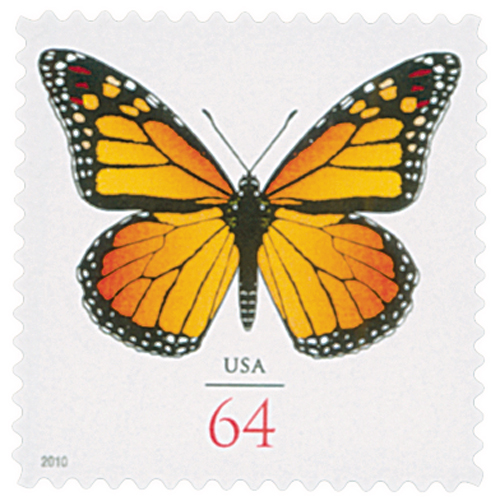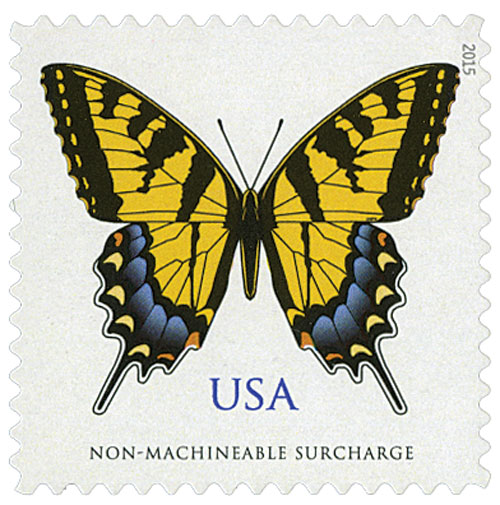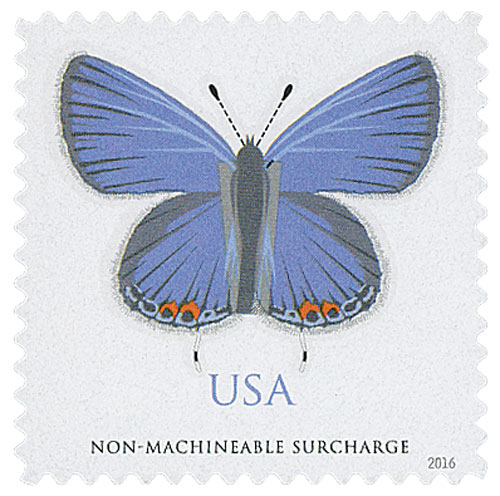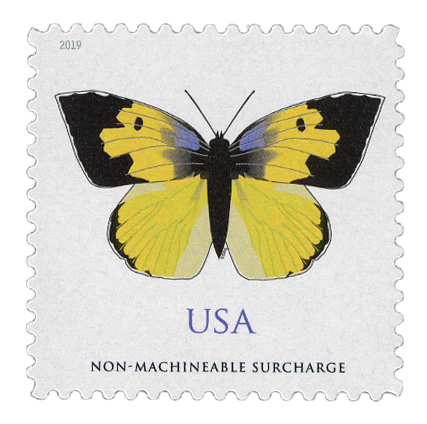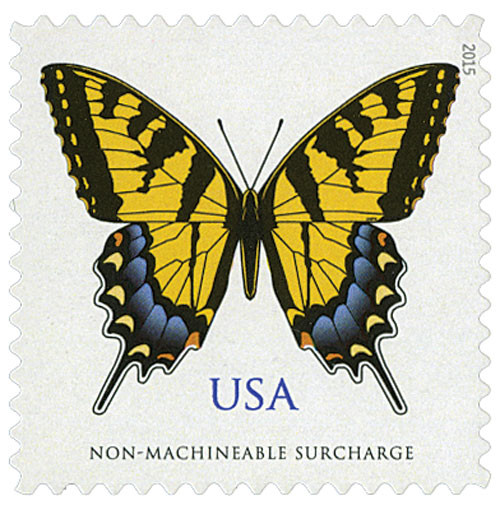
# 4736 PB - 2013 66c Spicebush Swallowtail Butterfly
Â
2013 66¢ Spicebush Swallowtail Butterfly
Butterfly Series
Â
When the young larva hatches, it eats part of the leaf and exudes silk. This causes the leaf to fold over the larva, creating a shelter. The young larva is generally a brownish color, similar to bird droppings – its first stage of mimicry to ward off predators. When the larva grows older, it turns a yellow-green color and has two large black spots with white dots on its head – resembling a snake. It also has a red y-shaped organ it exposes when attacked, that mimics a snake’s tongue.
Â
The swallowtail’s mimicry continues as an adult, as it resembles a pipevine swallowtail, which is a foul-tasting butterfly many predators know to avoid. The spicebush swallowtail flies close to the ground, unlike most butterflies. It also flutters its wings while it feeds, while other species stop to feed. These traits help give a unique identity to a species that spends much of its life mimicking other creatures.
Butterfly Series
In late 2009, the USPS unveiled the first butterfly stamp for greeting card envelopes that required additional postage (an extra 20¢) than the standard one-ounce rate covered. This would apply to envelopes that couldn’t be sorted on the USPS’s automated equipment, otherwise known as “nonmachinable.â€
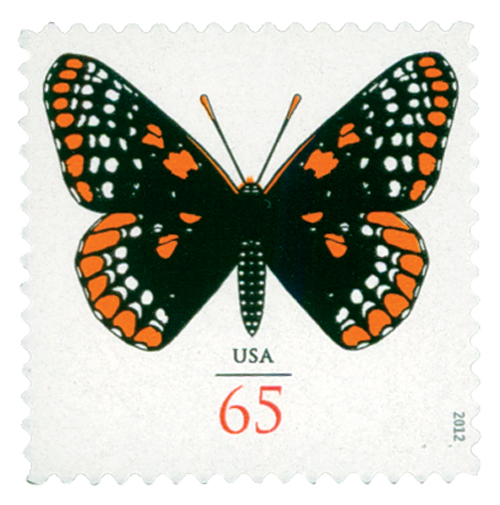
Some of these nonmachinable envelopes include those that are oddly-shaped or vertical, lumpy, rigid, or with clasps, ribbons, or buttons on them. Even if an envelope weighed less than one ounce, but was unmachinable, it would need this stamp. However, letters that were simply heavy didn’t necessarily need it. The two-ounce rate at the time was 61¢, and this stamp was 64¢, so they would be overpaying by 3¢ if they used it.
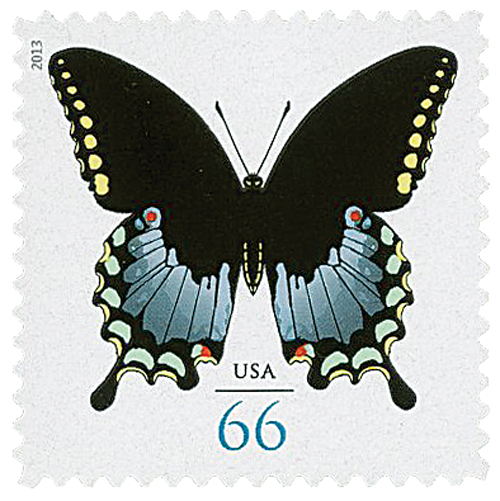
The USPS worked closely with the greeting card industry on this new stamp. Prior to this issue, some greeting card envelopes would be imprinted with “extra postage required.â€Â With the creation of this new stamp, the Greeting Card Association encouraged its members to print a butterfly silhouette on the envelopes of cards that would require this additional postage. Reflecting this close working relationship, the 64¢ monarch butterfly stamp was issued on May 17, 2010, at the National Stationery Show held at the Jacob Javits Center in New York.

The monarch stamp remained in use for two years, being replaced by the Baltimore checkerspot butterfly stamp in 2012 when the nonmachinable rate increased to 65¢. New stamps were issued each year through 2016. The 2015 and 2016 followed the Forever format, in printing “non-machinable surcharge†on the stamp, rather than the actual denomination.
The California dogface butterfly stamp was initially announced in 2016 and expected for a 2017 release. However, the USPS said that they had designed the stamp, but wouldn’t produce it until supplies of existing butterfly stamps were nearly depleted. So that stamp wasn’t issued until 2019.
Click here to view lots more US and worldwide butterfly stamps.
Â
Â
2013 66¢ Spicebush Swallowtail Butterfly
Butterfly Series
Â
When the young larva hatches, it eats part of the leaf and exudes silk. This causes the leaf to fold over the larva, creating a shelter. The young larva is generally a brownish color, similar to bird droppings – its first stage of mimicry to ward off predators. When the larva grows older, it turns a yellow-green color and has two large black spots with white dots on its head – resembling a snake. It also has a red y-shaped organ it exposes when attacked, that mimics a snake’s tongue.
Â
The swallowtail’s mimicry continues as an adult, as it resembles a pipevine swallowtail, which is a foul-tasting butterfly many predators know to avoid. The spicebush swallowtail flies close to the ground, unlike most butterflies. It also flutters its wings while it feeds, while other species stop to feed. These traits help give a unique identity to a species that spends much of its life mimicking other creatures.
Butterfly Series
In late 2009, the USPS unveiled the first butterfly stamp for greeting card envelopes that required additional postage (an extra 20¢) than the standard one-ounce rate covered. This would apply to envelopes that couldn’t be sorted on the USPS’s automated equipment, otherwise known as “nonmachinable.â€

Some of these nonmachinable envelopes include those that are oddly-shaped or vertical, lumpy, rigid, or with clasps, ribbons, or buttons on them. Even if an envelope weighed less than one ounce, but was unmachinable, it would need this stamp. However, letters that were simply heavy didn’t necessarily need it. The two-ounce rate at the time was 61¢, and this stamp was 64¢, so they would be overpaying by 3¢ if they used it.

The USPS worked closely with the greeting card industry on this new stamp. Prior to this issue, some greeting card envelopes would be imprinted with “extra postage required.â€Â With the creation of this new stamp, the Greeting Card Association encouraged its members to print a butterfly silhouette on the envelopes of cards that would require this additional postage. Reflecting this close working relationship, the 64¢ monarch butterfly stamp was issued on May 17, 2010, at the National Stationery Show held at the Jacob Javits Center in New York.

The monarch stamp remained in use for two years, being replaced by the Baltimore checkerspot butterfly stamp in 2012 when the nonmachinable rate increased to 65¢. New stamps were issued each year through 2016. The 2015 and 2016 followed the Forever format, in printing “non-machinable surcharge†on the stamp, rather than the actual denomination.
The California dogface butterfly stamp was initially announced in 2016 and expected for a 2017 release. However, the USPS said that they had designed the stamp, but wouldn’t produce it until supplies of existing butterfly stamps were nearly depleted. So that stamp wasn’t issued until 2019.
Click here to view lots more US and worldwide butterfly stamps.
Â




